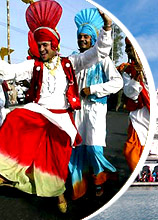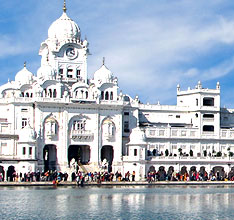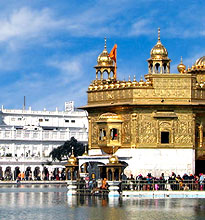 Ludhiana is one of the richest cities in Punjab, centrally located on the National Highway 1, which goes from Delhi to Amritsar. The city stands on the Sutlej River's old bank, 13 km to the south of its present course. It serves as the headquarters of the Ludhiana district and falls in the Malwa region of Punjab. On the northern side, river Sutlej separates it from district Jalandar. The river also forms its northern boundary with Hoshiarpur District. On other sides, Ludhiana shares common boundaries with Rupnagar District in the east, Moga District in the west and Sangrur and Patiala districts in the south and southeast, respectively.
Ludhiana is one of the richest cities in Punjab, centrally located on the National Highway 1, which goes from Delhi to Amritsar. The city stands on the Sutlej River's old bank, 13 km to the south of its present course. It serves as the headquarters of the Ludhiana district and falls in the Malwa region of Punjab. On the northern side, river Sutlej separates it from district Jalandar. The river also forms its northern boundary with Hoshiarpur District. On other sides, Ludhiana shares common boundaries with Rupnagar District in the east, Moga District in the west and Sangrur and Patiala districts in the south and southeast, respectively.It was founded at the time of Lodhi Dynasty, which ruled Delhi from 1451 AD to 1526 AD. As per the legend, Lodhi Chief Yusuf Khan and Nihand Khan were deputed by Sikander Lodhi to restore order in the region that was oppressed by the Baluchis. The army of Lodhis fixed the site of Ludhiana, then called Mir Kota, as their battle point. Yousuf Khan went across the river Sutlej in Jalandhar Doab and made a settlement at Sultanpur. Nihand Khan stayed back and founded the present city, at the site of the village Mir Hota. Originally, the city was called Lodhi-ana meaning Lodhi's. Later, it was given the present name of Ludhiana.
Ludhiana is the largest city in Punjab, with an area about 310 square km. The topography of the district is typically representative of an alluvial plain. It owes its origin to the aggravation work of the Sutlej River. The alluvium deposited by the river has been worked over by the wind, giving rise to a number of small dunes and sand mounds. The ground is of yellow sandstone and granite, forming small hillocks, plateaus and dips. The Sutlej and its tributaries and the Budha Nallah constitute the chief Hydrographic features of the district.
Ludhiana is known as the "Manchester of India”, because it forms the industrial hub of Punjab. There are 8 large integrated knitwear factories, roughly 6,000 small to medium-sized knitwear factories (like Oswals, Nahar), 10 big hosiery yarn mills and 150 small to medium sized woolen yarns therein. The city also has a number of firms manufacturing hero cycles, avon cycles, machine tools, sewing machines, generators etc. It won the first place in the list of 17 Indian cities, in a survey conducted by the World Bank (as per 2009 report).
How to Reach Ludhiana
Ludhiana is one of the most commercially significant towns of Punjab. The city, rich in historical legacy and traditional values, attract tourists from all over the world, every year. There is a well-developed infrastructure in Ludhiana, which connects it to various parts of the world. It has excellent network of roadways and railways.
Shopping in Ludhiana
Ludhiana has a number of things to offer to its tourists, which they would want to take back home. All over the city, there are innumerable shops selling various items catering to the daily needs of the people. There is a grand display of Punjab's traditional handicrafts, like phulkari, jootis, parandis, jewelries, dress materials etc.
Tourist Attractions in Ludhiana
Spread over an area of 30 acres, Nehru Rose Garden is in the Civil Lines area of Ludhiana. It serve as an open ground for people to have morning and evening walks, exercises and also offers some priceless moments of relaxation. There are more than 17,000 plants here, representing 1,600 varieties of roses, apart from several fountains. Every year, a Rose Festival is held here, which attracts lots of tourists.
Ludhiana Weather
Ludhiana is basically a dry district of Punjab, which witnesses extreme summer and winter season. The climate of the district can be mainly classified as tropical steppe, hot and semi-arid. There is ample moisture during the monsoon season, owing to the moist air of oceanic origin that penetrates into the place.











